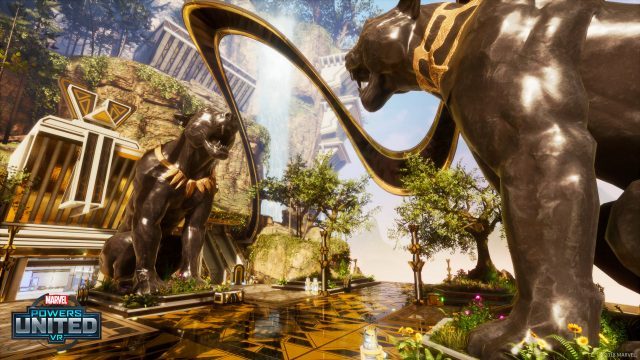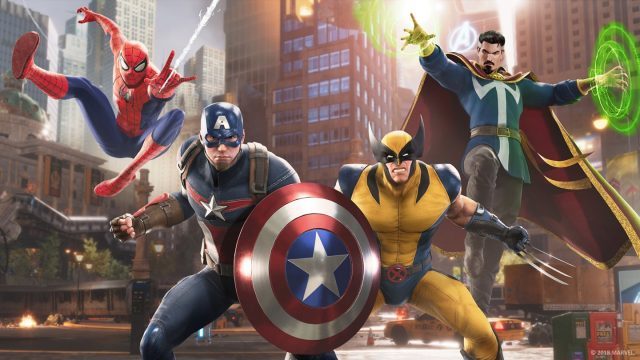Marvel Powers United may not have turned out to be an instant classic, but with a big name IP and 18 playable characters, the game represents a bar of scope and polish arguably never before seen in a made-for-VR title. The game’s executive producer tells us that Marvel Powers United represents one of, it not the largest content investment Oculus Studios has made to date. What’s more, the studio has no intention of slowing down its content investment trajectory.
Oculus Studios’ Mike Doran, executive producer on Marvel Powers United, told Road to VR at a recent press event that the investment in the game is “among the biggest, if not the biggest to date. The number of people, the amount of time we spent on it, the ambitions we had for the number of characters we wanted to get in there—we went big everywhere.”
Marvel Powers United launched last week to mixed reviews, though many reviews agree (ours included) that the game’s visual polish and attention to character detail is a strong point. The game had a two year development cycle, Doran said; that’s somewhat common for traditional AAA games, but nearly unheard of in VR—at least for a game with the scope of Powers United.


“For [Oculus] Studios specifically, our bets have gotten bigger, our budgets have gotten bigger,” he said. “The amount of resources we’re able to put into something like this versus a Touch launch title are much greater, and you’re going to see that come through on the screen.”
Last year, Oculus’ Head of Content, Jason Rubin, told us that Oculus Studios had moved from investing hundreds of thousands of dollars per project, in the early days of Rift development, to several million per project. It seems likely that Marvel Powers United VR, with its two year development cycle and major IP, fell into that new upper tier.
A two year lead on development would have put the beginning of the game’s production all the way back to July 2016, some six months before the company even launched the Touch motion controllers—nearly ancient history with how fast VR is moving. This early genesis could explain the game’s foundation of wave shooting and coarse motion input interactions, as Oculus had to build a prototype for Marvel’s consideration, and didn’t have the benefit of learning from a handful of great titles which would come months later and pioneer many aspects of motion control gameplay.
While the game itself had a long lead time, the Rift + Marvel Powers United VR bundle didn’t come into the picture until the beginning of 2018, Doran said. The bundle, which officially launches today in select countries, is the first time that Oculus is putting a major piece of content front and center on the package, emulating a tried and true strategy often employed by console makers.
The bundle makes it clear that Oculus has high hopes for the game to attract new users into the company’s PC VR ecosystem, beyond just pleasing existing headset owners. “We hope it sells a boatload of [headsets]—that is the ultimate goal [of the bundle]” Doran said.
The company doesn’t just want the game to be a poster child for the headset, they have plans for post-launch support, Doran says, as long as players keep coming back for more.
“[User retention] sort of ties into our DLC philosophy. There will be DLC for the game, it will be free, we’re going to be generous with the community—we’re not talking what or when quite yet, but as long as people keep coming back and playing, we’re going to keep making stuff.”
And while Oculus Studios sounds committed to delivering DLC for Marvel Powers United VR, it sounds like plans are still being formulated as to what that content might look like.
“I think what we want to do [with DLC] is get the game out there, get it in the hands of the fans, and let them tell us what they want more of. Obviously we could come up with no shortage of cool scenarios that we could script and put people in, or stories that we would want to retell, but you have to fit it in a structure—you only have so much resources and time and ability to get stuff done,” Doran said. “This was the choice we made, we wanted to lean heavily into the multiplayer and the co-op social aspects; we’re going to see how the fans react and what they want more of.”
At a minimum, Doran assured us that DLC will be free and microtransactions are not part of the plan.
“No microtransactions. The chests that we have in the game—or loot boxes if you will—those are purely cosmetic and fun cool collectible stuff; they do not make you better at the game or more powerful or anything like that. And it’s really about being as friendly as possible to the community. You invested in the game, we want you to be happy, we want to give you more cool stuff, so as long as you keep playing, we’ll keep making it.”
Now with Marvel Powers United VR out the door, and with Defector and Stormland now on the horizon, what’s next for Oculus Studios? Doran wasn’t ready to spill any secrets, but said quite firmly that when it comes to investing in new VR content, “We’re not slowing down.”
Disclosure: Oculus paid for local transportation for Road to VR to attend an event where information for this article was gathered.

